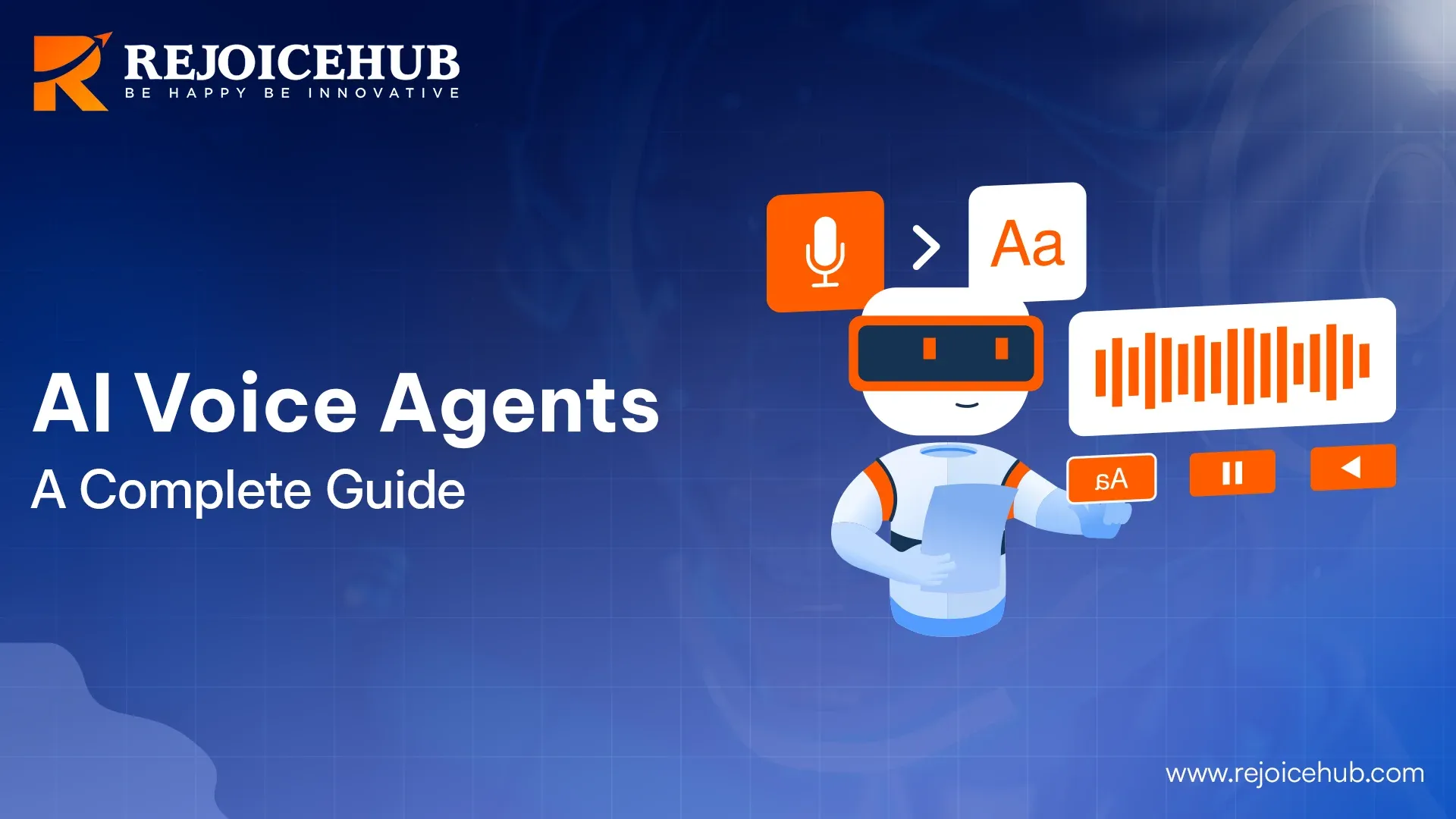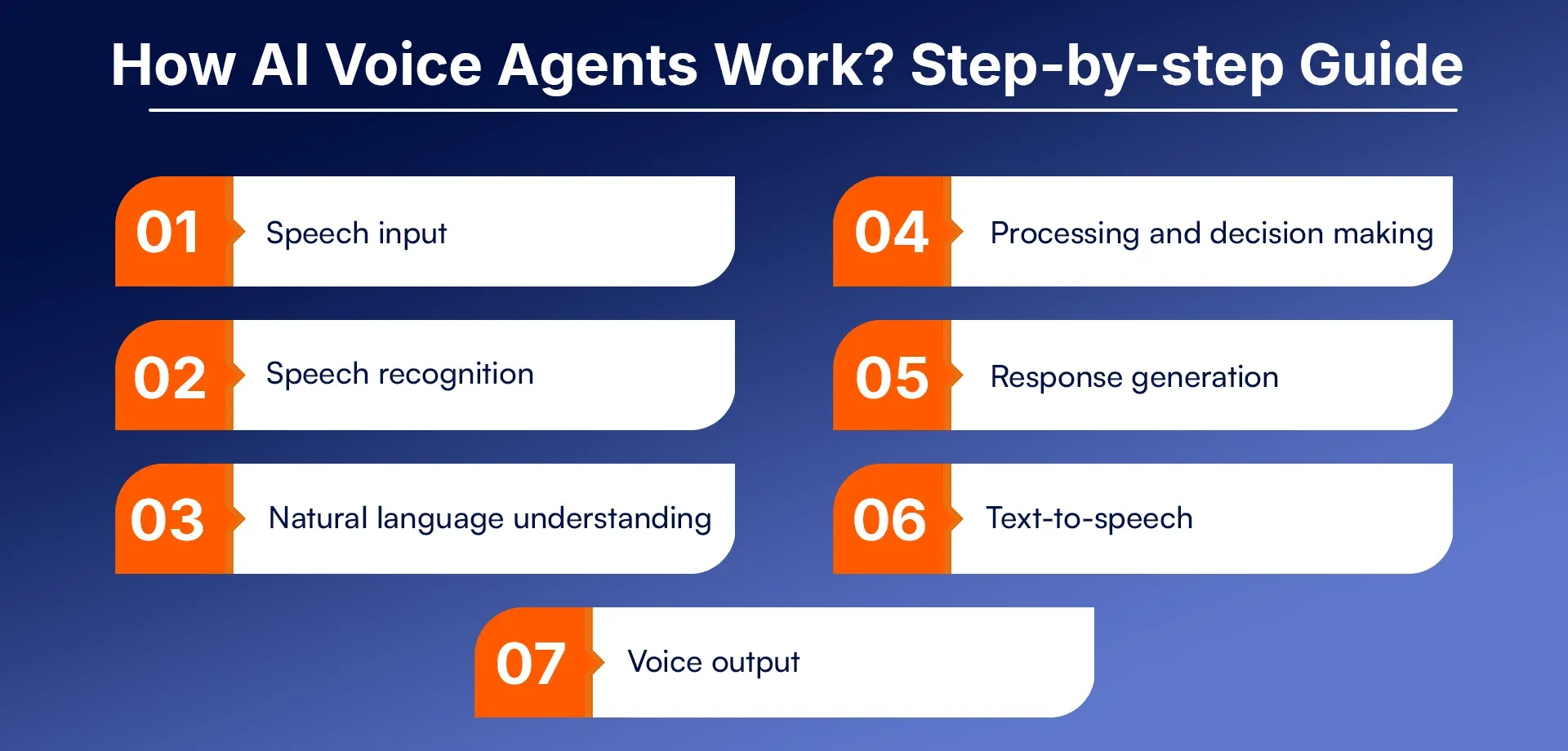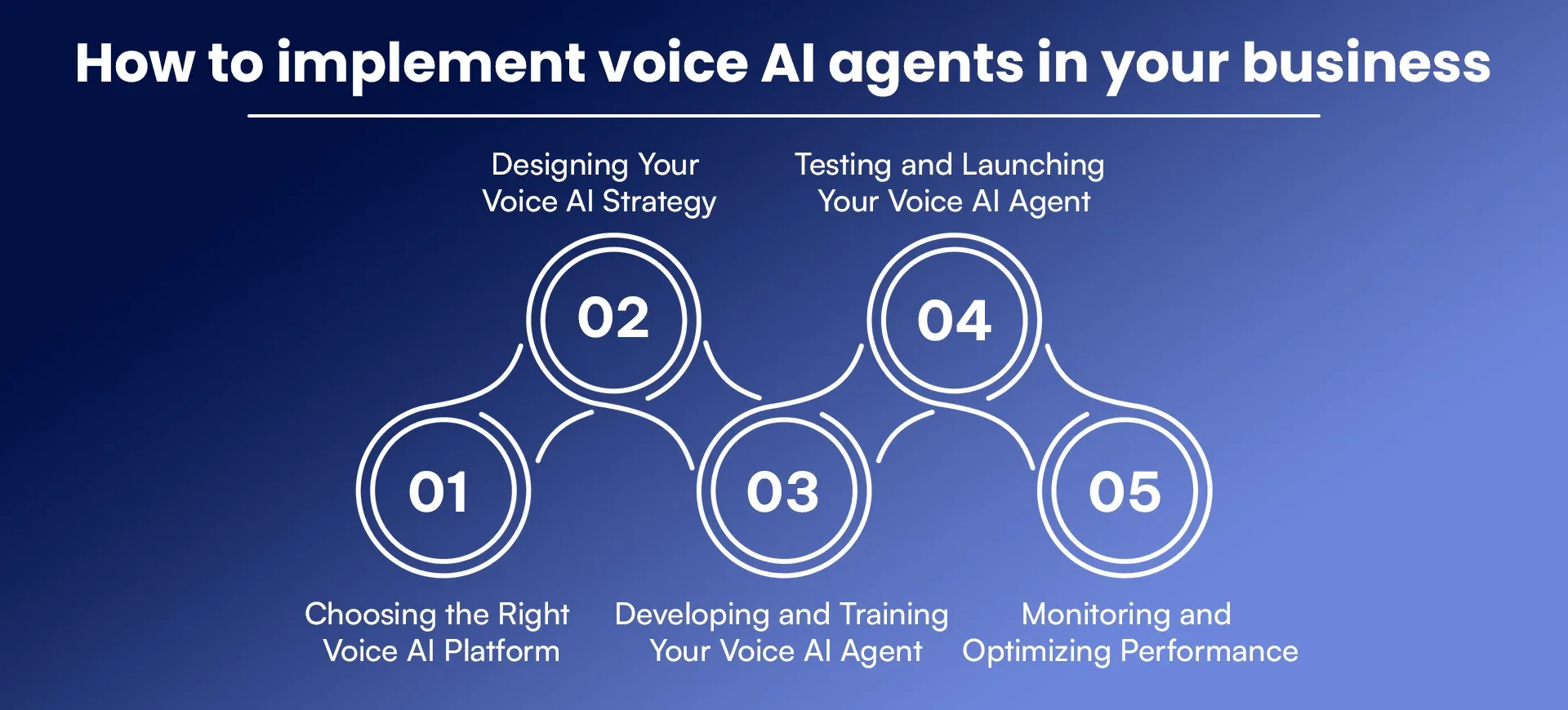
"Alexa, what's the weather today?"
"Hey Siri, call Mom."
Sound familiar? You already know about AI voice agents, right? These digital friends have changed how we use technology. One simple voice command and they have made our daily life easier.
Quick Summary
AI voice agents are smart programs that listen, understand, and talk back. They have moved beyond simple phone menus to become perfect helpers. They answer customer questions. They control our smart home gadgets and tools. They're transforming how businesses operate and how we manage our daily lives.
What Are AI Voice Agents?
AI voice agents are digital helpers who understand when you talk to them. Unlike old automated systems that followed complex scripts, these modern assistants learn from every chat. They adjust to your way of speaking. They get better with practice.
They are like virtual team members who never need sleep or breaks. They can chat with thousands of people at once without getting tired. We all know Alexa, Google Assistant, and Siri. But voice agents now work in many places you might not expect.
Today's voice agents can do amazing things. They schedule your meetings. They answer every question. They process payments. Some can even tell if you sound upset or happy. They combine several smart technologies like speech recognition, language processing, machine learning, and voice creation.
All these pieces work together so you can have a natural conversation with a machine.
How AI Voice Agents Work - Step-by-Step Guide
AI Voice Agents use advanced technologies like natural language processing (NLP), automatic speech recognition (ASR), and machine learning to understand spoken language, process requests, and respond in real-time. This step-by-step guide breaks down how these virtual agents convert voice input into meaningful, human-like interactions to assist users across various industries. Ever wonder what happens in that short moment between asking your phone a question and hearing an answer back? Here's the process broken down.

1. Speech Input
It starts when you speak. Your voice makes sound waves. Tiny microphones in your device catch these waves. These physical vibrations need to become digital signals that computers can work with.
2. Speech Recognition
Your device turns these sound waves into digital form. Special software called Automatic Speech Recognition breaks your speech into basic sounds. It matches these sounds to words it knows. Modern systems can even ignore background noise and tell different speakers apart.
3. Natural Language Understanding
Just knowing the words isn't enough. The system needs to figure out what you mean. This is where things get clever. The AI analyzes grammar and context to understand your intent. It knows "How do I make a new account?" is different from "How do I log into my account?" It catches these subtle differences.
4. Processing and Decision Making
Once it understands what you want, the AI decides how to help. It searches its knowledge or connects to other systems. It might check weather services, search product databases, or connect to your bank account. It finds what it needs to answer you.
5. Response Generation
Now the AI creates its answer. Smart language generation helps it sound natural, not robotic. Good systems adjust their style based on the conversation. They might be formal for banking questions but casual for movie recommendations.
6. Text-to-Speech
The AI's text answer becomes spoken words. Modern voice systems sound amazingly human. They use the right pace, emphasis, and even emotional tone. Some can sound excited, concerned, or reassuring.
7. Voice Output
Finally, you hear the response through your device's speakers. The whole process – from your question to the answer – usually takes just seconds. It feels like magic, but it's really clever engineering.
Key Technologies Behind AI Voice Agents
AI voice agents rely on a blend of advanced technologies to understand, process, and respond to human speech. Core components include Automatic Speech Recognition (ASR) to convert spoken words into text, Natural Language Processing (NLP) to interpret meaning, and Text-to-Speech (TTS) systems to generate human-like responses. These technologies are powered by machine learning and deep neural networks, enabling voice agents to continuously improve accuracy, context awareness, and conversational abilities. Let's look at what makes these voice agents tick

1. Automatic Speech Recognition (ASR)
This technology turns spoken words into text. Today's systems use deep learning to handle different accents and speaking styles. They get better by listening to more diverse voices.
The best systems get it right 95% of the time in quiet rooms. But real-world noise and multiple speakers still create challenges.
2. Natural Language Processing (NLP)
NLP helps machines understand and create human language. It's how voice agents understand meaning, spot the emotions, and follow the conversations without getting lost.
Recent breakthroughs, especially large language models, have made voice agents much better at complex questions. They can now have more natural, flowing conversations.
3. Machine Learning
Voice agents improve through machine learning. Every conversation teaches them something new. They use this data to get better over time.
This learning ability is crucial because humans speak in endless variations. Voice agents with machine learning spot patterns. They predict what users need. They personalize responses based on past chats.
4. Integration with the Internet of Things (IoT)
Voice agents become truly useful when connected to other systems. They can control smart devices around your home. "Turn off the lights" becomes a real action when your voice agent connects to smart bulbs.
In businesses, they connect to customer databases, knowledge systems, and payment platforms. These connections let them find and use the information they need to help you.
5. Text-to-Speech Technology
Modern systems create incredibly natural-sounding voices. They adjust tone and pacing to sound more human. Some can even match emotions in their voice to the conversation's context.
The best voice systems now sound so natural that callers often can't tell they're speaking with AI. The robotic voices of the past are disappearing fast.
Why Are Voice AI Agents Important?
Voice AI isn't just another tech fad. It represents a fundamental shift in how we work with computers. For decades, we've bent to the machine's will. We learned keyboards, mice, and touch screens. Now the tables have turned. Voice AI adapts to our most natural skill conversation.
This shift changes everything. One grandmother never touched a computer her whole life. She was intimidated by keyboards and menus. Yet she chats with Alexa every day. She checks the weather, plays music, and calls family members. Voice removed the barriers that kept her from technology.
Voice makes tech accessible to people with visual impairments. It helps those with limited mobility or reading skills. It reaches people with traditional interfaces left behind.
Speaking is simply faster than typing for most questions. You can ask for information while cooking dinner or driving. Voice lets you multitask safely.
It feels natural. We learn to speak as toddlers. We've had conversations our entire lives. Talking to a machine requires no special training. Even a child can do it.
As voice recognition gets even better, expect to see it become the main way we interact with technology in many situations. The keyboard won't disappear, but the voice will claim more territory each year.
Types of AI Voice Agents
AI voice agents come in various forms, each designed for specific tasks and industries. Common types include virtual assistants like Alexa or Siri, customer support agents for handling service queries, voice bots for call centers, interactive voice response (IVR) systems for routing calls, and AI-powered transcription agents for converting speech to text. These agents use natural language processing and machine learning to understand and respond to human speech effectively. Voice agents come in different flavours, each with specific talents. Here are the main types.
1. Customer Service Agents
These digital helpers manage customer questions and simple transactions. When calling an internet provider about an outage, their voice agent might ask about the problem, verify identity, and check service status in the area. All without human involvement.
These agents route calls to the right department. They answer common questions that used to bog down human agents. They process routine transactions like bill payments. They gather customer information before transferring to humans. They create summaries after calls end.
The real magic? They handle the repetitive stuff so human agents can focus on complex problems. The problems that need empathy, creativity, and human judgment.
2. Personal Assistants
These are the voice agents most people know best. They help manage daily life through reminders and information.
Many people use them to check calendars while getting dressed. They ask for weather updates before leaving home. They control music while cooking. They set timers, add items to shopping lists, and control smart home devices. All by simply asking.
Personal assistants shine in moments when pulling out your phone would be inconvenient. They let you check traffic conditions while tying your shoes. They play workout playlists while you're already stretching. Small conveniences add up to a smoother day.
3. Voice-Activated Business Tools
These specialized helpers make office work more efficient. They provide hands-free access to business systems.
Sales representatives might dictate notes after client meetings. They schedule follow-ups and set reminders by voice. Teams create reports and retrieve documents using voice commands. No typing required.
These tools particularly help mobile workers. Think of a warehouse manager checking inventory while walking the floor. Or a field technician retrieving repair instructions while their hands are busy with tools.
4. Specialized Industry Solutions
Some voice agents focus on specific industries with unique needs and vocabulary.
Doctors use medical voice assistants to document patient visits without breaking eye contact. Lawyers have assistants that search case law using legal terminology. Factory workers follow complex procedures with step-by-step voice guidance.
These specialized agents understand industry jargon. They follow sector-specific regulations. They integrate with specialized equipment and software. They're custom-built for specific professional environments.
Wat Are the Benefits of Voice AI Agents?
Voice AI agents offer numerous benefits, including improved customer service, faster response times, 24/7 availability, and reduced operational costs. They can handle multiple queries simultaneously, ensure consistent communication, and provide a more natural, hands-free user experience across industries.Voice AI creates wins for both businesses and their customers. Here are the main advantages.

1. Ined Operations
Voice agents never sleep. They handle routine questions around the clock without human help. This lets companies manage more customer interactions without hiring more staff.
A utility company used to get flooded with calls during power outages. Their call center would buckle under the pressure. Now their voice agent handles status updates and estimated repair times. Human agents focus on emergency situations instead. Everyone gets faster service.
2. Anced Customer Experience
Nobody likes waiting on hold. Voice agents respond instantly. They're available every hour of every day. They deliver consistent answers regardless of when you call. They also remember your history. When calling a mobile provider's voice agent about upgrading a plan, it can remember preferences and previous questions. It feels personal, not generic.
3. Cost Reduction
Let's talk bottom line. Voice automation saves money. The upfront investment pays off quickly for high-volume contact centers.
A bank saved $5 million in one year after adding voice AI. Their common questions – balance checks, recent transactions, branch hours – now route to AI. Even better, their customer satisfaction actually improved. Callers got faster answers without waiting.
4. Multilingual Support
Voice agents speak multiple languages fluently. No need for separate teams of multilingual staff.
A travel company expanded from serving English speakers to helping customers in Spanish, French, German, and Japanese. Their voice agent switches languages instantly. This opened new markets without massive hiring.
5. Scalability
Human teams can't scale instantly. Voice AI can. During holiday shopping peaks, insurance claim surges after storms, or tax season rushes, voice agents maintain performance regardless of volume.
A retail customer service manager shared that their call volume triples during December. Their voice system handles the surge without breaking a sweat. No more seasonal hiring scrambles.
6. Accessibility
Voice opens doors for people with different abilities. Visually impaired users gain independence. People with motor limitations access services hands-free. Those intimidated by technology find a familiar interface – conversation.
7. Data Collection and Analysis
Every voice interaction creates valuable data. Companies analyze these conversations to spot customer pain points. They discover common questions. They identify emerging problems before they grow.
A software company noticed their voice agent getting many questions about a specific feature. This highlighted confusion in their product design. They updated the interface and saw help requests drop by 40%. The voice agent had revealed an issue they hadn't recognized.
Also Read: How Can AI Agents Help Automate Your Workflows in 2025
Use Cases for Voice AI Agents
Voice AI agents are intelligent systems that use natural language processing and speech recognition to interact with users through voice. They can automate customer service, assist in hands-free device control, streamline workflows, and enhance accessibility. Common use cases include virtual assistants, call center automation, smart home control, voice-based search, and voice-enabled healthcare support. These agents improve user experience, reduce operational costs, and offer 24/7 support across industries. Here's how real industries use voice agents today.

1. Banking/Finance
Banks use voice agents for the bread and butter of customer service. Balance checks. Transaction history. Bill payments. Fraud alerts.
Some now use voice biometrics for security. Your voice pattern becomes your password. No more remembering complex phrases or PINs.
A manager at a national bank reported their voice system now handles 70% of routine customer inquiries. Wait times dropped 85%. Customer satisfaction scores stayed strong.
2. Retail
Retailers use voice for order tracking, product questions, and inventory checks. Voice shopping grows more popular each year. During holiday rushes, voice agents keep things moving. A retail executive described their voice system as "our secret weapon for Black Friday." It handles the predictable questions while human agents tackle the complex issues.
3. Telecommunications
Telecom companies face unique challenges. They help customers with technical problems, explain complicated bills, and manage service changes.
Some now offer "virtual technicians." These voice specialists walk you through router setups or device configurations step by step. They guide you through fixing common problems without sending a human technician.
4. Healthcare
Healthcare organizations use voice for appointment scheduling and medication reminders. Some offer symptom checkers and insurance information.
Voice works especially well for patients with mobility issues. Instead of struggling with small buttons on phone screens, they simply speak their needs.
Medical providers also use voice systems for documentation. Doctors dictate notes while maintaining eye contact with patients. The personal connection improves while record-keeping stays accurate.
What Are the Challenges of Voice AI Agents?
Voice AI agents face several challenges, including natural language understanding, context retention, and accurate speech recognition. These agents must handle varied accents, speech patterns, and noisy environments while maintaining a seamless, conversational flow. Additionally, ensuring privacy and security while processing sensitive data is crucial. There are also challenges in achieving emotional intelligence to make interactions more human-like and in managing user trust. Finally, adapting voice AI to diverse languages and dialects while minimizing biases remains a significant hurdle. Despite their impressive capabilities, voice agents still face real hurdles. Here's what still needs work.

1. Contextual Understanding
Humans make conversational leaps that confuse AI. We refer back to previous statements. We use pronouns. We leave important information unsaid.
Imagine this simple chat - "What's the weather like today?" "It's sunny. What about tomorrow?" "Will I need an umbrella?"
Following this conversation requires remembering we're talking about weather. It means knowing "it" refers to the weather. It means connecting "umbrella" with rain probability. These connections come naturally to humans but challenge AI systems.
One test with a voice assistant involved a similar conversation. It handled the first two exchanges perfectly. Then it got confused by the umbrella question. "I'm not sure what you're asking about," it replied. The connection seemed obvious but stumped the AI.
2. Accuracy
Even the best speech recognition systems struggle sometimes. Strong accents cause problems. Background noise confuses them. Technical terms and unusual names get misheard.
Many people with non-Western names constantly struggle with voice systems. They rarely recognize their names correctly. Some resort to using English nicknames with voice assistants. It's frustrating and alienating when technology repeatedly misunderstands you.
3. Emotional Intelligence
Human service agents pick up subtle emotional cues. They can tell when you're frustrated, confused, or anxious. They adjust their approach accordingly.
Voice AI is getting better at detecting basic emotions. But it still misses the nuances. It might not recognize growing frustration in your voice. It might not sense when you need extra patience or a different approach.
How to Implement Voice AI Agents in Your Business
Implementing Voice AI agents in your business can enhance customer support, automate tasks, and improve user experiences. Leverage AI to streamline communication and boost efficiency. Ready to bring voice AI to your company? Here's a simple roadmap to get started.

Step 1 - Choosing the Right Voice AI Platform
You have several paths to voice AI implementation.
Some companies build custom solutions from scratch. This works if you have unique needs and strong technical teams. Most businesses find existing platforms more practical.
Cloud services make implementation easier. Google's Dialogflow, Amazon Lex, IBM Watson Assistant, and Microsoft's Bot Framework offer proven tools. They handle the heavy lifting of speech recognition and language processing.
Some vendors create industry-specific solutions. These come with relevant terminology and workflows already built in. A healthcare-focused platform understands medical terms. A banking platform knows financial vocabulary.
When picking a platform, consider language support for your customer base. Check integration options with your existing systems. Look at analytics capabilities. Verify security and compliance certifications.
Step 2 - Designing Your Voice AI Strategy
Success starts with clear planning. Voice projects can fail because teams skip this critical step.
Begin by identifying the right use cases. Focus on common, repetitive tasks with clear resolution paths. Billing questions, order status checks, and information requests make good starting points.
Map the customer journey through your voice system. Plan entry points into conversations. Design smooth flows that feel natural. Create clear paths to human agents when needed.
Define concrete success metrics. Will you measure call containment rates? Customer satisfaction scores? Average handling time? Cost savings? Knowing your goals shapes your implementation.
Don't forget personality development. Your voice agent becomes part of your brand. Its tone and language should match your company culture. A banking voice agent might sound professional and reassuring. A gaming company's agent might be casual and energetic.
Step 3 - Developing and Training Your Voice AI Agent
With your strategy set, start building your voice agent.
Create a solid knowledge base. Gather FAQs, product details, policies, and procedures. Your agent needs this information to answer questions accurately.
Design conversation flows for common scenarios. Include appropriate responses, clarifying questions, and fallback options for when it gets confused.
Train your system to recognize different ways people ask the same thing. Customers might say "I want to check my balance," "How much money do I have?" or "What's in my account?" Your agent needs to understand these all mean the same thing.
Connect your voice agent to your backend systems. It might need access to CRM platforms, payment processors, booking systems, or product databases.
Step 4 - Testing and Launching Your Voice AI Agent
Never skip thorough testing. Voice systems need real-world practice before going live.
Start with internal users who understand the system's limitations. Your employees can provide valuable feedback while forgiving early mistakes.
Launch a pilot program with a small customer group. Gather their feedback and make improvements before wider release. Test unusual scenarios and edge cases. How does your agent handle strong accents? What about background noise? Will it recognize when to transfer to humans?
Roll out gradually rather than all at once. This lets you monitor performance and make adjustments without risking your entire customer base.
Step 5 - Monitoring and Optimizing Performance
Voice AI implementation isn't a one-time project. It's an ongoing process of improvement.
Review conversation transcripts regularly. Look for misunderstandings and successful interactions. Spot opportunities to improve your system.
Use actual customer conversations to retrain your agent. This improves its ability to recognize intents and generate accurate responses.
Track performance metrics on dashboards. Watch containment rates, customer satisfaction scores, and handling times. These numbers tell you where you're succeeding and where you need work.
Regularly expand your agent's capabilities. Add new features based on common customer requests. Keep growing your voice AI as technology and customer needs evolve. voice agent to your backend systems. It might need access to CRM platforms, payment processors, booking systems, or product databases.
- Ambient Computing: Voice interfaces will become more embedded in our environment, available through smart speakers, cars, appliances, and public spaces.
As these technologies mature, the line between human and AI assistance will continue to blur, creating more natural and capable voice experiences.
Conclusion
AI voice agents represent a fundamental shift in how we interact with technology moving from typed commands and touchscreens to natural conversation. For businesses, they offer significant opportunities to improve efficiency, enhance customer experiences, and reduce operational costs.
While challenges remain in creating truly natural conversations, the technology continues to advance rapidly. Organizations that thoughtfully implement voice AI now will gain valuable experience and competitive advantage as voice becomes an increasingly dominant interface.
At the forefront of this transformation is RejoiceHub, enabling businesses to harness the power of AI voice agents with cutting-edge solutions tailored to real-world needs. By focusing on seamless integration and user-centric design, RejoiceHub helps companies unlock the full potential of voice technology.
The question isn't whether voice will transform customer interactions, but when and how organizations will adapt to this change. Those who embrace the technology strategically, focusing on customer needs rather than technological novelty, will be best positioned to thrive in the voice-first future.
Frequently Asked Questions
How accurate are AI voice agents?
Leading speech recognition systems achieve accuracy rates above 95% in ideal conditions. However, performance can vary significantly based on factors like accent, background noise, vocabulary, and speech patterns.
Can voice agents understand different accents?
Most modern voice systems are trained on diverse speech samples and can handle various accents, though some may still struggle with strong regional accents or unusual speech patterns.
How do voice agents protect privacy?
Reputable voice AI platforms encrypt conversations, offer data retention controls, and provide transparency about how voice data is used. Many also offer on-premises deployment options for sensitive industries.
Can voice agents integrate with our existing systems?
Yes, most voice AI platforms offer APIs and pre-built connectors for common business systems. Custom integrations can be developed for specialized systems.
How long does it take to implement a voice AI solution?
Implementation timelines vary based on complexity. Simple use cases using cloud platforms can launch in weeks, while sophisticated enterprise deployments might take several months.
Do we need technical expertise to implement voice AI?
Cloud-based platforms have significantly reduced the technical barrier to entry. While some technical knowledge is helpful, many platforms now offer user-friendly interfaces for building and managing voice agents.
